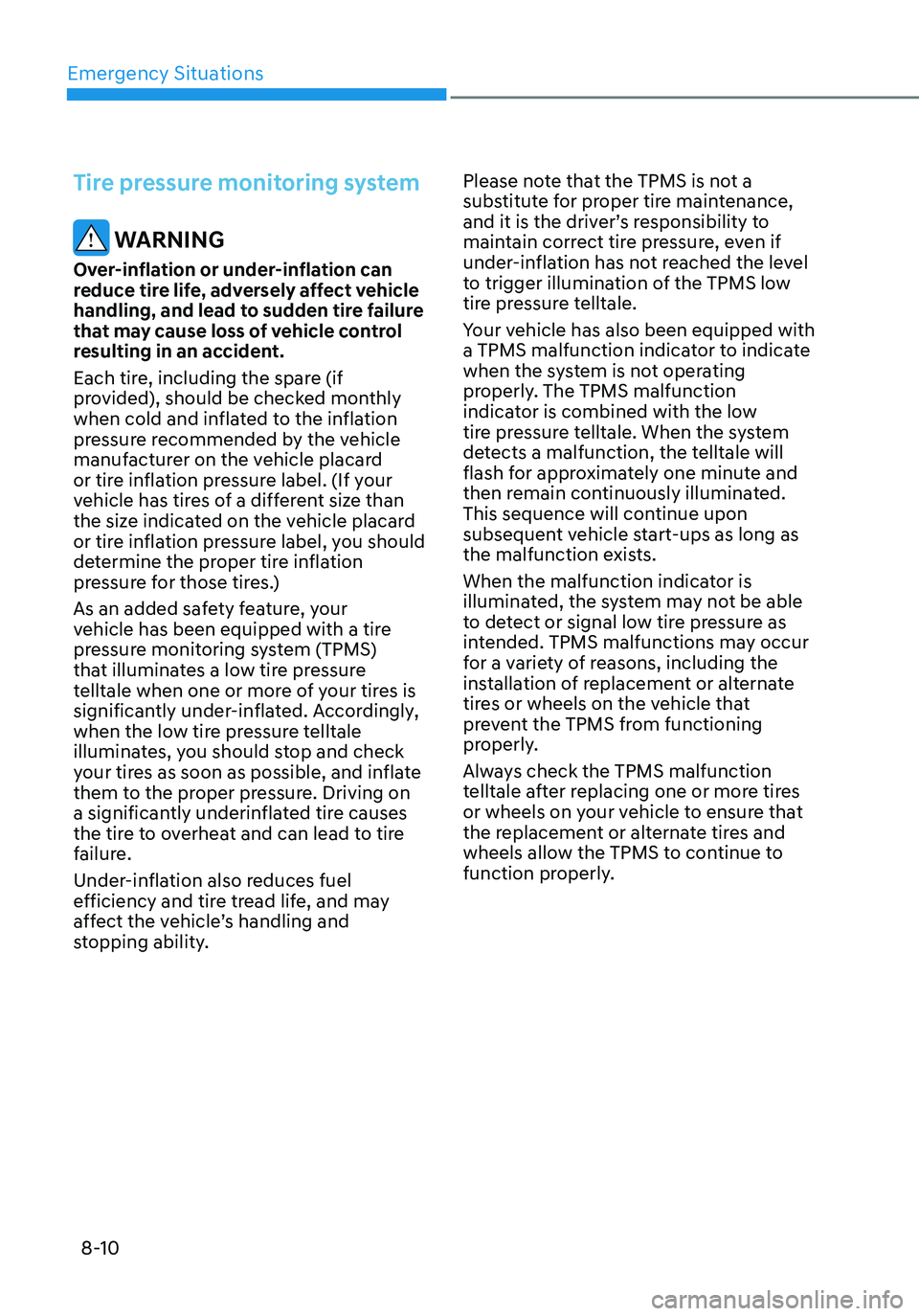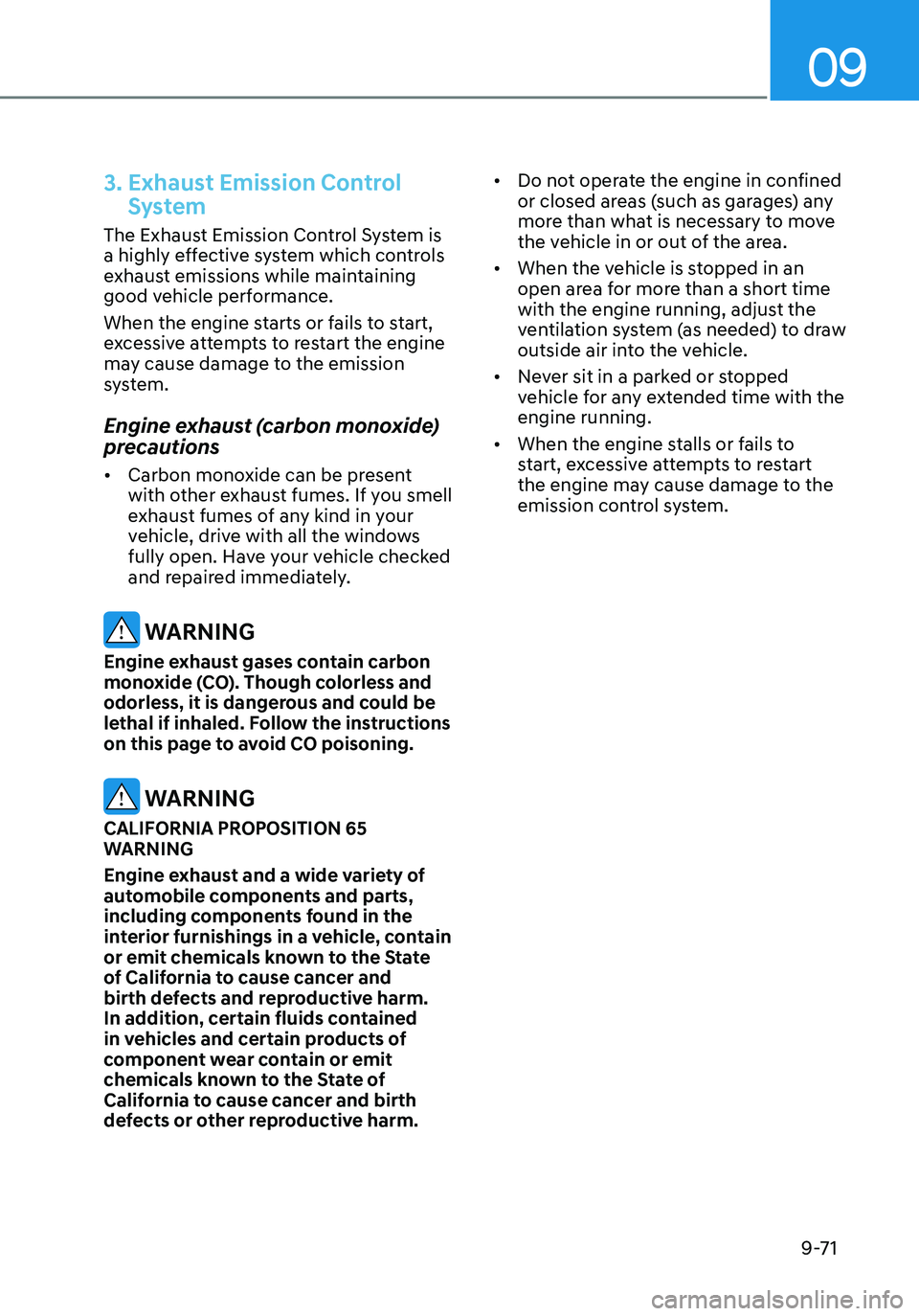2021 HYUNDAI ELANTRA HYBRID stop start
[x] Cancel search: stop startPage 455 of 555

Emergency Situations
8-10
Tire pressure monitoring system
WARNING
Over-inflation or under-inflation can
reduce tire life, adversely affect vehicle
handling, and lead to sudden tire failure
that may cause loss of vehicle control
resulting in an accident.
Each tire, including the spare (if
provided), should be checked monthly
when cold and inflated to the inflation
pressure recommended by the vehicle
manufacturer on the vehicle placard
or tire inflation pressure label. (If your
vehicle has tires of a different size than
the size indicated on the vehicle placard
or tire inflation pressure label, you should
determine the proper tire inflation
pressure for those tires.)
As an added safety feature, your
vehicle has been equipped with a tire
pressure monitoring system (TPMS)
that illuminates a low tire pressure
telltale when one or more of your tires is
significantly under-inflated. Accordingly,
when the low tire pressure telltale
illuminates, you should stop and check
your tires as soon as possible, and inflate
them to the proper pressure. Driving on
a significantly underinflated tire causes
the tire to overheat and can lead to tire
failure.
Under-inflation also reduces fuel
efficiency and tire tread life, and may
affect the vehicle’s handling and
stopping ability.Please note that the TPMS is not a
substitute for proper tire maintenance,
and it is the driver’s responsibility to
maintain correct tire pressure, even if
under-inflation has not reached the level
to trigger illumination of the TPMS low
tire pressure telltale.
Your vehicle has also been equipped with
a TPMS malfunction indicator to indicate
when the system is not operating
properly. The TPMS malfunction
indicator is combined with the low
tire pressure telltale. When the system
detects a malfunction, the telltale will
flash for approximately one minute and
then remain continuously illuminated.
This sequence will continue upon
subsequent vehicle start-ups as long as
the malfunction exists.
When the malfunction indicator is
illuminated, the system may not be able
to detect or signal low tire pressure as
intended. TPMS malfunctions may occur
for a variety of reasons, including the
installation of replacement or alternate
tires or wheels on the vehicle that
prevent the TPMS from functioning
properly.
Always check the TPMS malfunction
telltale after replacing one or more tires
or wheels on your vehicle to ensure that
the replacement or alternate tires and
wheels allow the TPMS to continue to
function properly.
Page 515 of 555

Maintenance
9-46
Driver’s side fuse panel
Fuse NameFuse Rating
Circuit Protected
MEMORY1 10AA/C Controller, Instrument Cluster,
A/C Control Module, Driver IMS Control Module
AIR BAG2 10A
SRS Control Module
MODULE4 10AIBU, ATM Shift Lever Indicator, Front Console Switch,
ADAS Unit, Crash Pad Switch, LKA Unit, VESS Unit
MODULE7 7.5AIAU, ADAS Unit, Rear Seat Wamer Control Module,
Cooling Fan Motor
START 7.5ABurglar Alarm Relay, Transaxle Range Switch, IBU,
Ignition Switch
BATTERY
MANAGEMENT 10A
BMS Control Module
CLUSTER 7.5A
Instrument Cluster (IG1)
IBU2 7.5A
IBU
A/C1 7.5AA/C Controller, A/C Control Module, PM Sensor,
E/R Junction Block (Blower Relay, PTC Heater1/2 Relay),
Electronic A/C Compressor
TRUNK 10A
Trunk Relay
S/HEATER FRT 20AFront Ventilation Seat Control Module,
Front Seat Warmer Control Module
P/WINDOW LH 25A
Power Window Main Switch
MULTIMEDIA 15A
Audio, A/V & Navigation Head Unit
SPARE 1 (B+) 10A
Not Used (Black Box)
FCA 10A
Front Radar
MDPS 7.5A
MDPS Unit
MODULE6 7.5A
IBU
S/HEATER RR 20A
Rear Seat Warmer Control Module
SAFETY P/
WINDOW DRV 25A
Driver Safety Power Window Module
P/WINDOW RH 25APassenger Power Window Switch,
Power Window Main Switch
BRAKE SWITCH 10A
IBU, Stop Lamp Switch
IBU1 15A
IBU
Page 540 of 555

09
9-71
3. Exhaust Emission Control
System
The Exhaust Emission Control System is
a highly effective system which controls
exhaust emissions while maintaining
good vehicle performance.
When the engine starts or fails to start,
excessive attempts to restart the engine
may cause damage to the emission
system.
Engine exhaust (carbon monoxide)
precautions
• Carbon monoxide can be present
with other exhaust fumes. If you smell
exhaust fumes of any kind in your
vehicle, drive with all the windows
fully open. Have your vehicle checked
and repaired immediately.
WARNING
Engine exhaust gases contain carbon
monoxide (CO). Though colorless and
odorless, it is dangerous and could be
lethal if inhaled. Follow the instructions
on this page to avoid CO poisoning.
WARNING
CALIFORNIA PROPOSITION 65
WARNING
Engine exhaust and a wide variety of
automobile components and parts,
including components found in the
interior furnishings in a vehicle, contain
or emit chemicals known to the State
of California to cause cancer and
birth defects and reproductive harm.
In addition, certain fluids contained
in vehicles and certain products of
component wear contain or emit
chemicals known to the State of
California to cause cancer and birth
defects or other reproductive harm. •
Do not operate the engine in confined
or closed areas (such as garages) any
more than what is necessary to move
the vehicle in or out of the area.
• When the vehicle is stopped in an
open area for more than a short time
with the engine running, adjust the
ventilation system (as needed) to draw
outside air into the vehicle.
• Never sit in a parked or stopped
vehicle for any extended time with the
engine running.
• When the engine stalls or fails to
start, excessive attempts to restart
the engine may cause damage to the
emission control system.
Page 548 of 555

Index
I-6
G
Guide to Hyundai Genuine Parts
........................................................................\
...1-3
H
Hazard Warning Flasher
........................................................................\
................8-2
HEV (Hybrid Electric Vehicle) System
.................................................................1-9
High Beam Assist (HBA)
........................................................................\
............5-76
Detecting sensor (Front view camera) .............................................................5-76
Function malfunction and limitations ..............................................................5-77
Function operation ........................................................................\
....................5-77
Function settings ........................................................................\
......................5-76
Highway Driving Assist (HDA)
........................................................................\
.7-92
Function malfunction and limitations ..............................................................7-96
Function operation ........................................................................\
....................7-94
Function settings ........................................................................\
......................7-93
Hood
........................................................................\
............................................5-62
How to Use This Manual
........................................................................\
...............1-4
Hybrid Starter & Generator (HSG) Belt
..............................................................9-22
Checking the Hybrid Starter & Generator (HSG) Belt ....................................9-22
Hyundai Motor America
........................................................................\
................1-2
I
If the 12 Volt Battery Is Discharged
......................................................................8-4
Before Jump Starting ........................................................................\
..................8-4
Jump Starting........................................................................\
.............................. 8-5
If the Engine Overheats
........................................................................\
.................8-7
If the Engine Will Not Start
........................................................................\
...........8-3
If you Have a Flat Tire (With spare tire)
.............................................................8-15
Changing Tires ........................................................................\
.........................8-16
Jack and Tools ........................................................................\
..........................8-15
Ignition Switch
........................................................................\
..............................6-4
Engine Start/Stop Button ........................................................................\
............6-7
Key Ignition Switch ........................................................................\
...................6-4
Important Safety Precautions
........................................................................\
.........3-2
Air Bag Hazards ........................................................................\
.........................3-2
Always Wear Your Seat Belt ........................................................................\
......3-2
Control Your Speed ........................................................................\
....................3-2
Driver Distraction ........................................................................\
.......................3-2